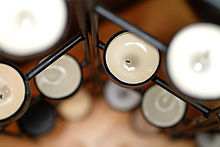Tealight
This article relies largely or entirely on a single source. (March 2017) |



A tealight (also tea-light, tea lites or tea light, tea candles, t-lite or tcandles), or nightlight, is a candle in a thin metal or plastic cup so that the candle can liquefy completely while lit. They are typically small, circular, wider than their height and inexpensive. Because of their small size and low level of light, multiple tealights are often burned simultaneously.
Tealights derive their name from their use in teapot warmers, but are also used as food warmers in general, e.g. fondue. They are a popular choice for votive candles. They are also suitable for accent lighting and for heating scented oil. Tealights may be set afloat on water for decorative effect.
Varieties
Tealights can come in many different shapes and sizes, small and large, as well as burn times and scents. However, tealights are commonly short and cylindrical, approximately 38 mm (1.5 in) in diameter by 16 mm (0.63 in) high, with white unscented wax.
A standard tealight has a power output of around 32 watts, depending on the wax used.[1]
Cup design
The wick is tethered to a piece of metal to stop it from floating to the top of the molten wax and burning out before the wax does.
Tealights have been protected under several patented designs. In some cases, the standard tea light metal cup has been replaced with a clear plastic cup, sometimes made out of polycarbonate plastic. The clear cup allows more light to escape the holder. However, the metal cups are much more common.
Holders
Tealights are especially popular for use with candle holders. From small pockets of glass, metal, ceramic, and other materials to larger, more elaborate tea light lamps, holders come in a wide range of styles, colours, and shapes. Holders have an appropriately sized cup to use a tealight candle, either scented or unscented. Discount stores, gift stores, and home decor stores often carry an array of holders for these small candles.
Electrical
Electric tealights have become increasingly popular as newer technology becomes available. They can feature incandescent or LED bulbs, the latter becoming the preferred format as LEDs become more-efficient and brighter. They can come in many different colours to set a mood, match a decor or augment the container's design. Some can also simulate a moving flame with various mechanical or electronic animations.
Electric tealights are much safer than a flame-based tealight, and can be left unattended as there is no open flame or heat to worry about. This allows them to be placed inside freestanding lace structures, or in candle holders made from paper, wood or other flammable materials. They can also be made much smaller to fit where a large flamed-based tealight cannot.
Electric tealights are not useful as a source of heat, so they are not suitable for chafing dishes or other food warmers.
See also
- Hindenburg light
- Tea cosy, an insulated cover also used to keep a teapot warm
References
- ^ Andy Lillington (September 2014). "The ooLiTE: Thermoelectric Lighting for Cavers?".
External links
 Media related to Tealights at Wikimedia Commons
Media related to Tealights at Wikimedia Commons
